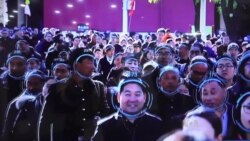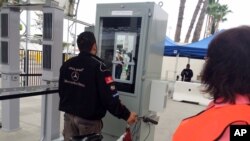From shopping centers and airports to concert venues and mobile phones, facial recognition technology can now be used in all of them due to advances in technology.
Countries including China and the United States are developing, testing and using facial recognition technology. At the Los Angeles International Airport, the U.S. Transportation Security Administration, or TSA, has been trying out several security devices, including a facial recognition technology that takes a picture of the passenger and compares it to the passport picture just before he or she goes through airport security.
“We're always looking at technology, processes, even doctrine changes on how to better our security at an airport,” said Steve Karoly, acting assistant administrator with the TSA's Office of Requirements and Capabilities Analysis.
If any one of the technologies being tested is implemented in the future, it will take two to three years for the TSA to install them in U.S. airports.
It is just one way facial recognition technology can be used for security.
Software to aid authorities
U.S. company FaceFirst has developed facial recognition software that can help police. Officers can take a picture of a suspect with a smartphone. The photo then can be compared to a database to see whether the person has a criminal history. The software can also be used in a private facility or store.
"We install a complete solution that allows our customers to be able to match people who are entering a facility against a database that already exists of bad people and so if there is a match that occurs, we're able to send an alert to a mobile device like an iPhone or an Android phone in near real time," said Peter Trepp, FaceFirst's chief executive officer.
Beijing start-up Horizon Robotics showed off its facial recognition applications at the Consumer Electronics Show in Las Vegas earlier this year by showing a crowded street in China as well as a store where faces are being captured.
“For surveillance, you can catch the face in the public and find what you want to find, and for the commercial use, you can find VIPs [very important persons] when they come to the store, and so you can have special service for them,” said Hao Yuan Gao of Horizon Robotics.
Strides in facial recognition technology
Facial recognition technology has made great advances in recent years.
“That has a lot to do with - computers are finally fast enough. We have GPUs (graphics processing units) and hardware that is fast enough to process all the data that we need to process,” said FaceFirst's Trepp.
Machines can now match faces that are not in a controlled environment with good lighting and a full shot. A side shot or moving image of the face may be enough for artificial intelligence to make a match.
“Where this is going is very exciting. We think about everyday items that we have that are going away. Our house keys, our car keys, our ATM cards, our passwords are all starting to go away and instead, we're going to be using facial recognition. Smartphones, of course are now using facial recognition. Laptops have facial recognition on them,” Trepp said.
“I think the fact that you can use this in uncontrolled environments makes it a much more interesting technology commercially,” said Prem Natarajan, research professor of computer science and the Michael Keston executive director at the University of Southern California Information Sciences Institute.
The idea of privacy
The ability to capture an image of a person without consent is a gray area when it comes to privacy, especially when many smartphones now have facial recognition in them so photos taken by the phone can pull up faces of friends with a timestamp and location information. On social media, such as Facebook, faces can be tagged. It is technology widely accepted and used by many people.
"There is visual of you, who you’re with, so it’s no longer just about your privacy. Whoever you’re with, the photos you’re taking of them, it’s like secondhand smoking – everybody you take a selfie with, etc., you’ve compromised as an individual their privacy, too, in some sense and we’re not seeking consent from any of them," Natarajan said.
However, the idea of privacy has evolved for the younger generation, who have grown up with the internet and social media.
"The new generation, I think, has a different perspective on privacy than we do. My kids, your kids, all of our kids are growing up in a much more shared experience world," Natarajan added. "My biggest privacy concern is actually not the government, it’s the big companies where there are really no limits on how they can share data, what they can use it for, how they can exploit it.”
"It’s a powerful tool and with power comes responsibility," Trepp said.
FaceFirst designed privacy into its software. The company says as the default setting, its surveillance footage of unknown people is automatically purged from the system at regular intervals.
Facial recognition researchers say a social framework should be created to guide the use of this technology so it can be used safely to benefit society and not exploit it.












